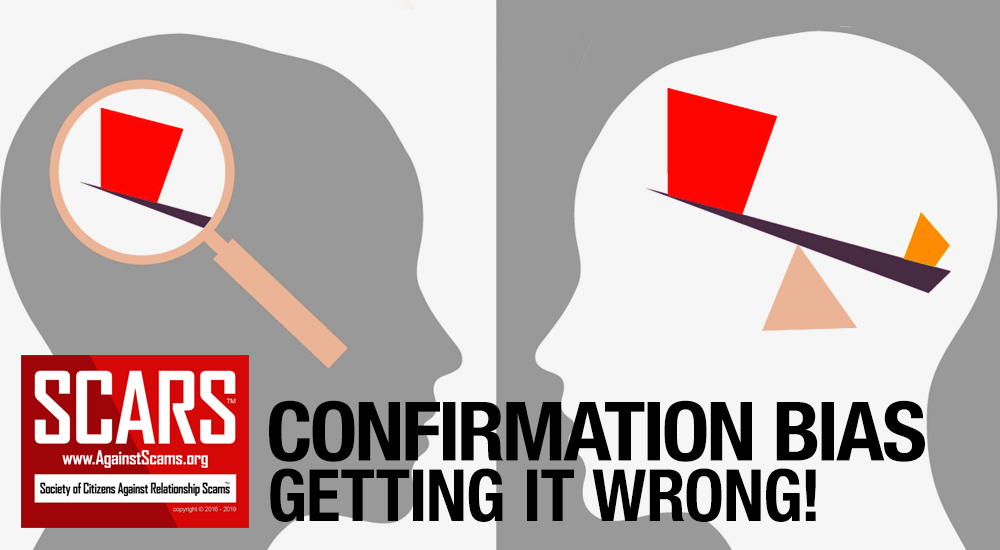Your Psychology Works Against You And Most People Tend To See What They Want To See!
Scam Victims Are Expertly Manipulated During The Course Of Their Romance Scam (And Other Types Of Scams Too) But Their Own Psychology Actively Contributes To Its Success!
One of the factors that contribute to both the initial hook and then the continuation of the scam is the victim’s own psychology. Each of us experiences the world subjectively based upon what we believe to be true. This is called “Confirmation Bias.”
con·fir·ma·tion bi·as
the tendency to interpret new evidence as confirmation of one’s existing beliefs or theories.
CONFIRMATION BIAS IS:
Confirmation bias is the tendency to search for, interpret, favor, and recall information in a way that confirms or strengthens one’s prior personal beliefs or hypotheses. It is a type of cognitive bias. People display this bias when they gather or remember information selectively, or when they interpret it in a biased way. The effect is stronger for desired outcomes, for emotionally charged issues, and for deeply-entrenched beliefs.
In other words, once you BELIEVE you are in a relationship that scammer is able to rely on your own Confirmation Bias to help sustain the relationship because the victim believes it is real!
People also tend to interpret ambiguous evidence as supporting their existing position. Biased search, interpretation, and memory have been invoked to explain:
- Attitude polarization (when a disagreement becomes more extreme even though the different parties are exposed to the same evidence)
- Belief perseverance (when beliefs persist after the evidence for them is shown to be false)
- Irrational primacy effect (a greater reliance on information encountered early in a series)
- Illusory correlation (when people falsely perceive an association between two events or situations)
All of these contribute to the continuation and maintenance of the scam AND facilitate the “gaslighting” that scammers use to isolate their victims.
A DEFINITION
Confirmation bias has also been called confirmatory bias or myside bias.
Confirmation bias is an example of cognitive bias, and also of apophenia – the general tendency to mistakenly perceive connections and meaning between unrelated things.
Confirmation biases are effects in information processing. They differ from what is sometimes called the behavioral confirmation effect, commonly known as a self-fulfilling prophecy, in which a person’s expectations influence their own behavior, bringing about the expected result.
Some psychologists restrict the term confirmation bias to a selective collection of evidence that supports what one already believes while ignoring or rejecting evidence that supports a different conclusion. Others apply the term more broadly to the tendency to preserve one’s existing beliefs when searching for evidence, interpreting it, or recalling it from memory.
BACKGROUND
A series of psychological experiments in the 1960s suggested that people are biased toward confirming their existing beliefs. Later work re-interpreted these results as a tendency to test ideas in a one-sided way, focusing on one possibility and ignoring alternatives. In certain situations, this tendency can bias people’s conclusions. Explanations for the observed biases include wishful thinking and the limited human capacity to process information. Another explanation is that people show confirmation bias because they are weighing up the costs of being wrong, rather than investigating in a neutral, scientific way. However, even scientists and intelligent people can be prone to confirmation bias.
Confirmation biases contribute to overconfidence in personal beliefs and can maintain or strengthen beliefs in the face of contrary evidence. Poor decisions due to these biases have been found in political, organizational, and scientific contexts. For example, confirmation bias produces systematic errors in research based on inductive reasoning.
Make-Believe Explanation
Developmental psychologist Eve Whitmore has argued that beliefs and biases involved in confirmation bias have their roots in childhood coping through make-believe, which becomes:
“the basis for more complex forms of self-deception and illusion into adulthood.”
The friction brought on by questioning as an adolescent with developing critical thinking can lead to the rationalization of false beliefs, and the habit of such rationalization can become unconscious over the years.
Individual Differences
“Myside bias,” also known as Confirmation Bias, was once believed to be correlated with intelligence; however, studies have shown that myside bias can be more influenced by the ability to rationally think as opposed to the level of intelligence. Myside bias can cause an inability to effectively and logically evaluate the opposite side of an argument. Studies have stated that myside bias is an absence of “active open-mindedness”, meaning the active search for why an initial idea may be wrong.
Typically, myside bias is operationalized in empirical studies as the quantity of evidence used in support of their side in comparison to the opposite side.
A study has found individual differences in myside or confirmational bias. A study investigated individual differences that are acquired through learning in a cultural context and are mutable. The researcher found an important individual difference in argumentation. Studies have suggested that individual differences such as:
- Deductive reasoning ability – (see below)
- Ability to overcome belief bias
- Epistemological understanding – the cognitive and intellectual functioning of an individual is significantly determined by his or her views on what knowledge is and how it is evaluated and acquired. These individual conceptions of knowledge and knowing determine one’s level of epistemological understanding. It is a process that starts with radical objectivism (knowledge as a certain and objective entity), leading through subjectivism, to an integration of both dimensions (allowing for uncertainty and the possibility to evaluate beliefs).
- Thinking disposition – a tendency toward a particular pattern of intellectual behavior. For example, good thinkers have the tendency to identify and investigate problems, to probe assumptions, to seek reasons, and to be reflective.
Those are significant predictors of the reasoning and generating arguments, counterarguments, and rebuttals.
A study by Christopher Wolfe and Anne Britt also investigated how participants’ views of “what makes a good argument?” can be a source of confirmational bias that influences the way a person formulates his own arguments (opinions or views). The study investigated individual differences of “argumentation schema” (an approach that allows someone to see the elements that conform an argument including all the relationships between the parts) and asked participants to write essays. The participants were randomly assigned to write essays either for or against their preferred side of an argument and were given research instructions that took either a balanced or an unrestricted approach. The balanced-research instructions directed participants to create a “balanced” argument, i.e., that included both pros and cons; the unrestricted-research instructions included nothing on how to create the argument.
We see this substantially when asking scam victims to look at potential fake scammer profiles. Most of the time they are unable to break it down and identify the true facts, but instead still rely on their confirmational bias – now altered – to simply declare it a scammer.
Overall, the results revealed that the balanced-thinking significantly increased the incidence of opposing information in arguments. These also reveal that personal belief is not a source of confirmational bias; however, those participants who believe that a good argument is one that is based on facts, are more likely to exhibit this bias than other participants. This evidence is consistent with the claims proposed in Baron’s article—that people’s opinions about what makes good thinking can influence how arguments are generated. In other words, their opinions about their own thinking influence their thinking!
According to Shahram Heshmat Ph.D.:
Confirmation bias occurs from the direct influence of desire on beliefs. When people would like a certain idea or concept to be true, they end up believing it to be true. They are motivated by wishful thinking. This error leads the individual to stop gathering information when the evidence gathered so far confirms the views or prejudices one would like to be true.
Once we have formed a view, we embrace information that confirms that view while ignoring, or rejecting, information that casts doubt on it. Confirmation bias suggests that we don’t perceive circumstances objectively. We pick out those bits of data that make us feel good because they confirm our prejudices. Thus, we may become prisoners of our assumptions. For example, some people will have a very strong inclination to dismiss any claims that marijuana may cause harm as nothing more than old-fashioned reefer madness. Some social conservatives will downplay any evidence that marijuana does not cause harm.
Wishful thinking is a form of self-deception, such as false optimism. For example, we often deceive ourselves, such as stating: just this one; it’s not that fattening; I’ll stop smoking tomorrow. Or when someone is “under the influence” he feels confident that he can drive safely even after three or more drinks.
Self-deception can be like a drug, numbing you from harsh reality or turning a blind eye to the tough matter of gathering evidence and thinking. As Voltaire commented long ago, “Illusion is the first of all pleasure.” In some cases, self-deception is good for us. For example, when dealing with certain illnesses, positive thinking may actually be beneficial for diseases such as cancer, but not diabetes or ulcers. There is limited evidence that believing that you will recover helps reduce your level of stress hormones, giving the immune system and modern medicine a better chance to do their work.
In sum, people are prone to believe what they want to believe. Seeking to confirm our beliefs comes naturally, while it feels strong and counterintuitive to look for evidence that contradicts our beliefs. This explains why opinions survive and spread. Disconfirming instances are far more powerful in establishing the truth. Disconfirmation would require looking for evidence to disprove it.
To learn more about Confirmation Bias see: https://en.wikipedia.org/wiki/Confirmation_bias
REASONING
Deductive Reasoning
Deductive reasoning is a basic form of valid reasoning. Deductive reasoning, or deduction, starts out with a general statement, or hypothesis, and examines the possibilities to reach a specific, logical conclusion, according to California State University. The scientific method uses deduction to test hypotheses and theories.
“In deductive inference, we hold a theory and based on it we make a prediction of its consequences. That is, we predict what the observations should be if the theory were correct. We go from the general — the theory — to the specific — the observations,” said Dr. Sylvia Wassertheil-Smoller, a researcher and professor emerita at Albert Einstein College of Medicine.
Deductive reasoning usually follows steps. First, there is a premise, then a second premise, and finally an inference. A common form of deductive reasoning is syllogism, in which two statements — a major premise and a minor premise — reach a logical conclusion. For example, the premise “Every A is B” could be followed by another premise, “This C is A.” Those statements would lead to the conclusion “This C is B.” Syllogisms are considered a good way to test deductive reasoning to make sure the argument is valid.
For example, “All men are mortal. Harold is a man. Therefore, Harold is mortal.” For deductive reasoning to be sound, the hypothesis must be correct. It is assumed that the premises, “All men are mortal” and “Harold is a man” are true. Therefore, the conclusion is logical and true. In deductive reasoning, if something is true of a class of things in general, it is also true for all members of that class.
According to California State University, deductive inference conclusions are certainly provided the premises are true. It’s possible to come to a logical conclusion even if the generalization is not true. If the generalization is wrong, the conclusion may be logical, but it may also be untrue. For example, the argument, “All bald men are grandfathers. Harold is bald. Therefore, Harold is a grandfather,” is valid logically but it is untrue because the original statement is false.
Inductive Reasoning
Inductive reasoning is the opposite of deductive reasoning. Inductive reasoning makes broad generalizations from specific observations. Basically, there is data, then conclusions are drawn from the data. This is called inductive logic, according to Utah State University.
“In inductive inference, we go from the specific to the general. We make many observations, discern a pattern, make a generalization, and infer an explanation or a theory,” Wassertheil-Smoller told Live Science. “In science, there is a constant interplay between inductive inference (based on observations) and deductive inference (based on theory), until we get closer and closer to the ‘truth,’ which we can only approach but not ascertain with complete certainty.”
An example of inductive logic is, “The coin I pulled from the bag is a penny. That coin is a penny. A third coin from the bag is a penny. Therefore, all the coins in the bag are pennies.”
Even if all of the premises are true in a statement, inductive reasoning allows for the conclusion to be false. Here’s an example: “Harold is a grandfather. Harold is bald. Therefore, all grandfathers are bald.” The conclusion does not follow logically from the statements.
Inductive reasoning has its place in the scientific method and is heavily used in daily life. Scientists use it to form hypotheses and theories. Deductive reasoning allows them to apply the theories to specific situations.
Abductive Reasoning
Another form of scientific reasoning that doesn’t fit in with inductive or deductive reasoning is abductive. Abductive reasoning usually starts with an incomplete set of observations and proceeds to the likeliest possible explanation for the group of observations, according to Butte College. It is based on making and testing hypotheses using the best information available. It often entails making an educated guess after observing a phenomenon for which there is no clear explanation.
This is where the scam victim uses reasoning to decide that a scammer is real. And then the manipulation and confirmation bias does the rest!
For example, a person walks into their living room and finds torn-up papers all over the floor. The person’s dog has been alone in the room all day. The person concludes that the dog tore up the papers because it is the most likely scenario. Now, the person’s sister may have brought his niece and she may have torn up the papers, or it may have been done by the landlord, but the dog theory is the more likely conclusion.
Abductive reasoning is useful for forming hypotheses to be tested. Abductive reasoning is often used by doctors who make a diagnosis based on test results and by jurors who make decisions based on the evidence presented to them.




I always thought there was an even chance that my scam experience was all fake, but I wanted it to be real. I feel like I gambled and lost.